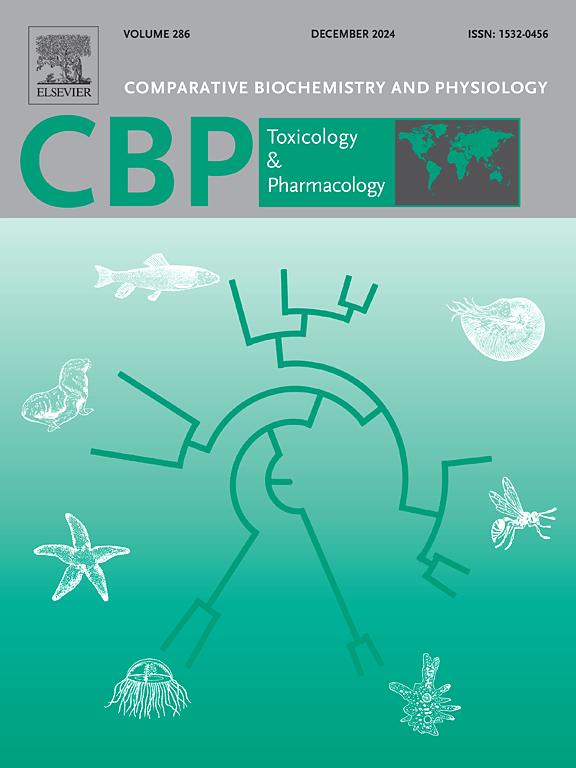Mechanism of blocking the glutamate pathway to exacerbate oxidative stress, ammonia toxicity and metabolic disorders in crucian carp (Carassius auratus) under saline-alkaline exposure
IF 3.9
3区 环境科学与生态学
Q2 BIOCHEMISTRY & MOLECULAR BIOLOGY
Comparative Biochemistry and Physiology C-toxicology & Pharmacology
Pub Date : 2025-02-17
DOI:10.1016/j.cbpc.2025.110146
引用次数: 0
Abstract
Climate change and intensified human activities have accelerated the salinization and alkalinization of aquatic environments, further shrinking the space for freshwater aquaculture. One of the key survival mechanisms for fish in saline-alkaline habitats is the conversion of accumulated endogenous ammonia into less toxic glutamine. This study focuses on the freshwater teleost, crucian carp (Carassius auratus), using the liver as the target organ. Three groups were established: 0, 20, and 40 mmol/L NaHCO3 stress groups. After 30 days, methionine sulfoximine was injected to block the glutamate pathway, respectively. Through a combination of biochemical analysis and metabolomics, this study investigated the mechanisms by which blocking the glutamate pathway under different NaHCO3 stress concentrations affects metabolism in the liver of crucian carp. Biochemical results indicated that saline-alkaline stress led to oxidative stress and impaired ammonia excretion in crucian carp, and these effects were exacerbated after blocking the glutamate pathway. Metabolomic results revealed significant alterations in pathways such as glycerophospholipid metabolism, arachidonic acid metabolism, and purine metabolism. The study demonstrates that blocking the glutamate pathway exacerbates lipid and energy metabolism disorders under saline-alkaline stress, with crucian carp compensating by regulating glucose metabolism to mitigate energy deficiencies. In summary, this study elucidates the metabolic changes in crucian carp following the blockade of glutamate pathway under carbonate-alkaline stress, providing insight into the mechanisms leading to liver inflammation and metabolic dysregulation, and offers preliminary insights into the effects on ammonia excretion, which lay a scientific foundation for future research on freshwater teleosts in saline-alkaline environments.

盐碱环境下,阻断谷氨酸通路加剧鲫鱼氧化应激、氨毒性和代谢紊乱的机制
气候变化和人类活动加剧加速了水生环境的盐碱化,进一步缩小了淡水养殖的空间。鱼类在盐碱环境中生存的关键机制之一是将积累的内源性氨转化为毒性较小的谷氨酰胺。本研究以淡水硬骨鱼鲫鱼(Carassius auratus)为研究对象,以肝脏为靶器官。建立0、20、40 mmol/L NaHCO3应激组。30天后,分别注射甲硫氨酸亚砜胺阻断谷氨酸通路。本研究通过生化分析和代谢组学相结合的方法,探讨了不同NaHCO3应激浓度下阻断谷氨酸通路对鲫鱼肝脏代谢的影响机制。生化结果表明,盐碱胁迫导致鲫鱼氧化应激和氨排泄受损,并在阻断谷氨酸通路后加重这些影响。代谢组学结果显示甘油磷脂代谢、花生四烯酸代谢和嘌呤代谢等途径发生了显著变化。研究表明,在盐碱胁迫下,阻断谷氨酸通路会加剧脂质和能量代谢紊乱,而鲫鱼通过调节葡萄糖代谢来弥补能量不足。综上所述,本研究阐明了碳酸盐-碱性胁迫下谷氨酸通路阻断后鲫鱼的代谢变化,揭示了肝脏炎症和代谢失调的机制,并初步了解了其对氨排泄的影响,为今后盐碱环境下淡水硬骨鱼的研究奠定了科学基础。
本文章由计算机程序翻译,如有差异,请以英文原文为准。
求助全文
约1分钟内获得全文
求助全文
来源期刊
CiteScore
7.50
自引率
5.10%
发文量
206
审稿时长
30 days
期刊介绍:
Part C: Toxicology and Pharmacology. This journal is concerned with chemical and drug action at different levels of organization, biotransformation of xenobiotics, mechanisms of toxicity, including reactive oxygen species and carcinogenesis, endocrine disruptors, natural products chemistry, and signal transduction with a molecular approach to these fields.

 求助内容:
求助内容: 应助结果提醒方式:
应助结果提醒方式:


